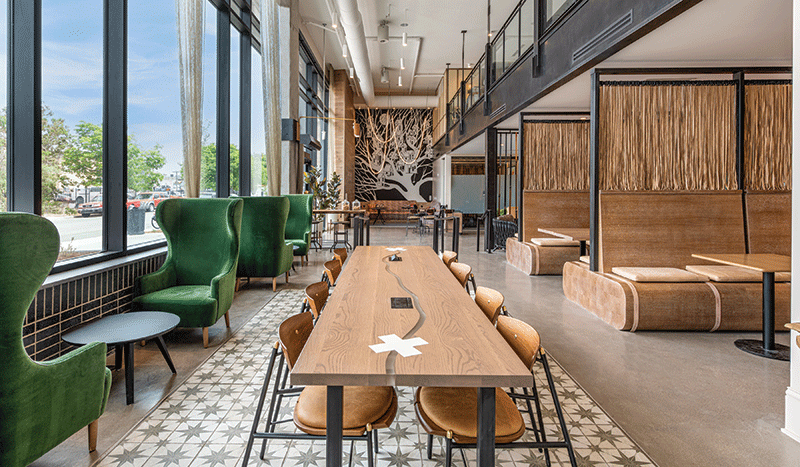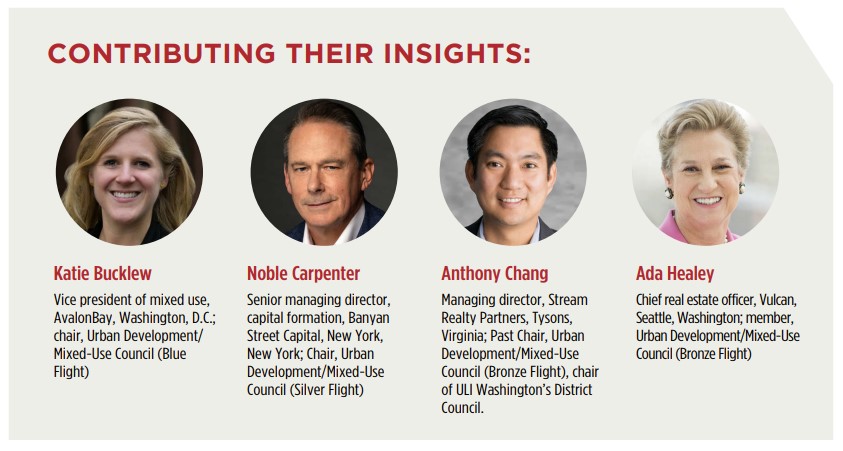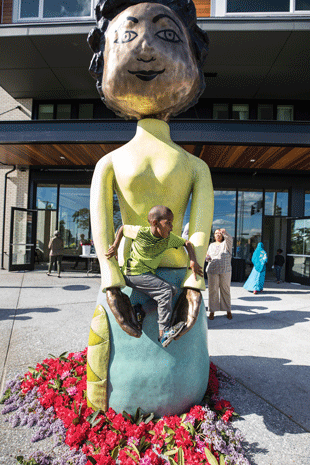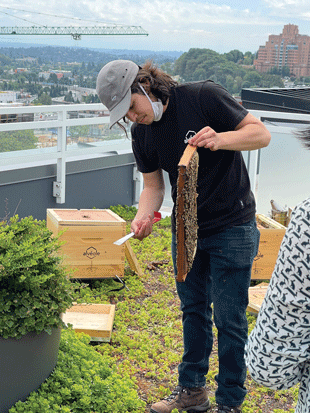
Avalon Bay’s AVA RiNo community in Denver Colorado features a coffee shop as part of an apartment building lobby and provides extra room for the retailer to expand its seating area for a more vibrant and dynamic atmosphere. (Teri Fotheringham Photography)
Experts speak about near-term prospects for development, challenges, and opportunities of obtaining financing in the current economic climate, strategies for balancing the mix of uses, ways mixed-use developments can better support local businesses, and other related trends.

Given the current economic climate, what are the prospects for developing mixed-use projects?
Katie Bucklew:Today’s environment is challenging due to rising costs. There has been a substantial decrease or flattening in rents, particularly for office and residential assets. And mixed-use development is inherently more expensive to build, operate, and maintain over the long term. For a vertically integrated product, you also have to align supply and demand for multiple asset classes. Of course, it takes a long time to plan new urban districts or a vertically integrated building, so time is on your side in the current environment. However, mixed use requires flexibility from municipalities and building departments.
Having too rigid plans can be problematic if market demand changes during the development process—you start to build and then realize no one wants to go into the office anymore, or retail consumption has altered, or the footprints have changed.
Anthony Chang:The only deals that are happening are backed by individuals or organizations that are doing deals all cash. Traditional developers and investors are struggling. I am seeing hope for smaller-scale projects, highly specific opportunities within mixed-use neighborhoods. For instance, introducing a smaller multifamily project to a downtown office neighborhood through adaptive reuse or development from scratch. Nowadays, developers and investors are finding more success improving the neighborhood itself with their investments rather than launching new traditional master-planned, mixed-use areas. They need to think about the ecosystem they are investing in and consider the best neighborhoods and markets for their projects. For example, Fulton Market in Chicago is thriving despite the overall struggles of the Chicago market.
Ada Healey:一个关键successful mixed-use projects is executing them in areas that have existing density and a mix of other uses in close proximity. We prefer having mostly a single use in a building with some retail at the base, while having complementary uses in tight proximity. In Seattle’s South Lake Union neighborhood, we’ve had some success with large mixed-use projects, but executing across multiple blocks separated by streets or other projects is less risky. Being close to rail and leveraging existing mixed-use neighborhoods is helpful. We pay particular attention to the design of the ground level, ensuring active uses and inviting spaces for pedestrians.
Noble Carpenter:When the pandemic hit, there was talk about whether cities would recover: people could work from anywhere, cities were too dense and unhealthy. However, it is abundantly clear that cities have come roaring back. Even downtown Los Angeles’ new multifamily developments are well leased, and developers are exceeding their rent expectations, despite downtown Los Angeles’ office vacancies. Successful new developments have vibrancy; there is excitement and a sense of place. The current challenge for new development is the upside-down financing market. The cost of debt and equity is very expensive, making development very difficult.

Community celebration of the installation of Saya Moriyasu’s artwork Maya at Vulcan Real Estate’s Batik, a seven-story apartment community in Seattle that includes 195 apartments over retail. (Vulcan Real Estate and Erin Lodi)
得出的挑战和机遇是什么ining financing?
Chang:The focus is on investors who are currently able to invest all cash, including sovereign high-net-worth organizations and high-net-worth families. The discussion around mixed use historically centered on billion-dollar projects, but now we are seeing activity on projects in the range of $10 million to $30 million in places like Virginia and Washington, D.C. These projects can be scalable for investors who aren’t dependent on financing. I think we will start seeing larger projects come into play in the next six to 18 months, contingent upon financing availability. Offices may be the canary in the coal mine. When you can start financing office projects again, that will be the inflection point for the broader market’s rebound.
Carpenter:Historically, when you had an idea for development, you could talk to your trusted equity sources and have a level of certainty about finding financing. Nowadays, you almost need to have financing lined up first before discussing a development plan with potential partners. Banks are overexposed to real estate and are looking to decrease their real estate loan portfolios. Even well-established developers are struggling to secure development financing. It’s a challenging time, and it will continue to be for another six months. Interest rates should start to decrease once there is consensus that inflation is under control. I’m extremely optimistic about the opportunities ahead.
Healey:If your project includes an office use, having it preleased is really important. In today’s capital market, being prepared to invest 50 percent or more equity to capitalize the project is likely required, due to liquidity constraints. Lenders have taken a much more conservative perspective on demand drivers and new supply. As the capital markets thaw, environmental sustainability and carbon reduction will present significant opportunities in terms of engaging with commercial customers.
Bucklew:Financing depends on the project’s size and scale. For example, if the commercial component on the ground floor is considered insignificant in the overall building’s pro forma, more emphasis will be placed on the largest and riskiest component—in most situations, the office or residential component. If you’re planning a large urban district with multiple uses and a substantial square footage for each component, the financial and asset class risk factors will all be considered more intricate and challenging.
What are good strategies right now for balancing the mix of uses?
Carpenter:I think it boils down to the right balance of live, work, play—I would include retail and hospitality under the “play” category. Every location and submarket is different, so the right mix changes from project to project.
Chang:Successful projects today share some common traits. They are backed by highly liquid and financially strong organizations. For example, our clients—like Federal Realty, which has historically focused on retail—are now making investments in mixed-use projects within their existing developments.
Similarly, public REITs like Boston Properties are diversifying into residential and hotel developments alongside their core focus on office properties. Bringing office users into a retail complex attracts more lunch and breakfast business, while bringing in residents drives dinnertime and weekend business to the neighborhood.
Healey:A human-centered approach is crucial to create a great retail experience. We’ve noticed significant interest in urban versions of mini-golf and bowling, virtual reality gaming, and other experiences that people can’t order online. Coming out of the pandemic, people have a real thirst to be together and have fun. We recently introduced a new retailer called Sandbox VR into one of our commercial office projects. It offers a virtual reality experience where you can immerse yourself in different themes, such as a fantasy theme, kind of likeGame of Thrones, making it a super fun activity to enjoy with friends. Food and drink offerings are also great.
Bucklew:Upfront planning is crucial for successful mixed-use developments. Making sure that the right stakeholders are involved from the beginning allows everyone to collaborate on how to design the spaces and incorporate the necessary flexibility. This may involve considering demising walls to accommodate potential changes in merchandising or determining how to handle back-of-house operations like trash, parking, and loading areas, which significantly impact a building’s operational capability.
How can mixed-use developments support equity and local businesses?
Healey:在西雅图地区,我们已经成功地布拉夫t in one-of-a-kind, single-store entrepreneurs along with national retailers that were first to enter the market. This approach creates a special and authentic retail experience. However, local businesses often lack the infrastructure and resources to design, construct, permit, and build their space, so we provide additional support. For example, for a project in Seattle’s Central District, which is a historically Black neighborhood, we sought Black entrepreneurs for the ground-floor retail spaces. We created three vanilla boxes, fully finished, about 600 square feet (56 sq m) each, and we leased all three of them to Black entrepreneurs. This allows them to test their product, make some money, and hopefully go on to expand their business.
Bucklew:Smaller-scale mixed-use buildings—where the retail component is typically a small component of the project—do a really good job of supporting equity and local businesses. Local retailers often have great brands and create stronger customer loyalty, resulting in a unique amenity for the residents or office employees upstairs. I believe smaller mixed-use developments are supporting many local businesses, which inherently leads to more stability. In AvalonBay’s portfolio, at least 75 percent of our tenants are local mom-and-pop businesses.
Chang:If we make capital and talent available, and align these resources in neighborhoods, letting them find their course, that will benefit local entrepreneurs. For example, in Alexandria, Virginia, a five-star restaurant with a famous chef closed [in 2018]. An entrepreneur, a Black-owned enterprise, bought the building, a small two-story building with a high-end restaurant and bar, and transformed it into an authentic, regionally focused establishment. They are doing exceptionally well, and they are aiming to buy additional sites and expand their brand. These long-term bets will be very equitable for the community, enabling expansion into neighboring communities that are underserved.
What other trends are you excited about?

A professional beekeeper tends the hives on the rooftop deck at Vulcan Real Estate’s Cypress, a seven-story, 237-unit apartment community in Seattle that includes ground-floor retail. (Vulcan Real Estate)
Bucklew:There’s more collaboration and thoughtfulness being applied to sharing space between different uses, including parking, patios, and back-of-house components. Developers are also integrating more uses, such as having office or residential lobbies open into active and vibrant areas. One example is in our AVA RiNo community in Denver, Colorado, where the apartment lobby integrates a local coffee shop, allowing retail customers to use and flow into the residents’ common space. This creates a more vibrant and dynamic atmosphere in the lobby while also allowing the retailer to expand their seating area. Except in extremely walkable urban areas, such as Manhattan or Washington, D.C., residents in multifamily buildings typically don’t utilize the lobby space for access as they come in/out of the parking structure. So, the retail use helps activate the street.
Carpenter:I think one of the most exciting trends is the densification of infill sites, especially the repurposing of office parks. Many of these projects are located in infill locations with excellent access to residential neighborhoods and retail. Retrofitting and densifying existing sites can be more environmentally friendly than building new. It’s hard, but it can present a significant opportunity for value creation and sustainable development.
Chang:Currently, office spaces are oversold, creating a lot of opportunities for experimentation and value creation. A client of ours, Federal Realty, has created a town hall environment within one of their older office buildings. Town halls are a winning strategy, reflecting the trend of turning office space into a more hospitality-oriented product and experience. This approach focuses on creating a durable luxury product that companies can use to bring employees back and to collaborate with clients. Town halls continue to outperform economically in terms of rental rates and leasing velocity.
Healey:With both our residential and office spaces, we are working hard to compete for customers. For our commercial customers, that means making the commute worthwhile, enticing people back to work. On the residential side, each new project aims to offer unique amenities that people value highly. One feature we introduced in one of our Seattle projects is honeybees on the roof of the building, next to an open space. A professional beekeeper tends to the bees, and the residents get to enjoy the honey. We’ve leased quite a few units to people who liked the idea of supporting wildlife resources. And they like getting fresh honey.
RON NYREN is a freelance architecture and urban design writer based in the San Francisco Bay area.

